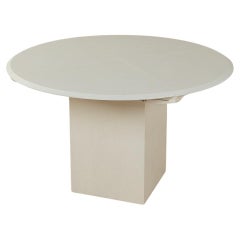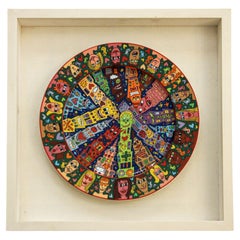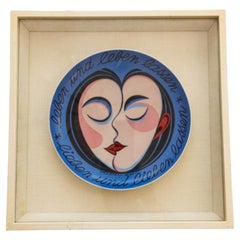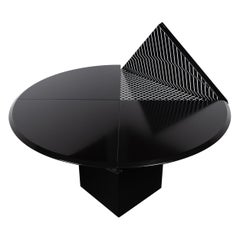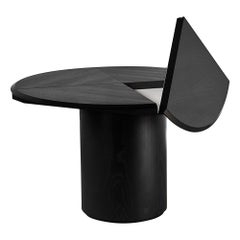Quadrondo Table
Antique 1680s German Mid-Century Modern Tables
Wood
Late 20th Century American Expressionist Decorative Art
Porcelain
Late 20th Century German Post-Modern Decorative Art
Porcelain
Recent Sales
Mid-20th Century German Post-Modern Dining Room Tables
Wood
Mid-20th Century German Mid-Century Modern Dining Room Tables
Wood
Vintage 1980s German Mid-Century Modern Dining Room Tables
Ash
Vintage 1980s German Dining Room Tables
Ash
Late 20th Century German Dining Room Tables
Late 20th Century Mid-Century Modern Dining Room Tables
Wood
Mid-20th Century German Mid-Century Modern Dining Room Tables
Oak
Mid-20th Century German Mid-Century Modern Dining Room Tables
Oak
Vintage 1980s German Minimalist Dining Room Tables
Wood, Paint
Late 20th Century German Mid-Century Modern Dining Room Tables
Metal
Vintage 1980s German Mid-Century Modern Dining Room Tables
Ash
21st Century and Contemporary European Modern Dining Room Tables
Wood
Late 20th Century German Mid-Century Modern Dining Room Tables
Wood
People Also Browsed
Mid-20th Century American Mid-Century Modern Centerpieces
Metal
Vintage 1960s American Minimalist Pedestals
Stainless Steel
2010s South African Minimalist Pedestals
Wood, Poplar, Burl
20th Century Moroccan Moorish Lanterns
Metal
21st Century and Contemporary American Modern Table Lamps
Plaster
Vintage 1930s Swedish Scandinavian Modern Decorative Boxes
Pewter
2010s Italian Modern Chaise Longues
Wood
Antique 1870s Victorian Crystal Serveware
2010s Italian Mid-Century Modern Wall Lights and Sconces
Brass
Vintage 1940s Swedish Mid-Century Modern Daybeds
Fabric, Alpaca, Wood
Antique Early 19th Century English Regency Centerpieces
Ceramic
Vintage 1930s German Folk Art Historical Memorabilia
Wire
Vintage 1970s Italian Mid-Century Modern Bedroom Sets
Steel, Chrome
21st Century and Contemporary Sofas
Upholstery
2010s American Modern Cabinets
Brass
Antique 15th Century and Earlier Chinese Tang Sculptures and Carvings
Terracotta
Rosenthal for sale on 1stDibs
While the Rosenthal Porcelain Factory grew from humble decorating roots — as many pottery companies do — it eventually built a list of universally revered designer and artist partners that included Andy Warhol and Salvador Dalí. And after securing an enviable position as a top manufacturer of serveware and dominating the porcelain and bone china markets, Rosenthal expanded into furniture production, working with influential designers Verner Panton, Luigi Colani and Günther Ferdinand Ris and Herbert Selldorf.
German-born Jewish businessman Philipp Rosenthal founded the company in 1879 in Bavaria. It began as his modest workshop where he painted porcelain and encountered success with porcelain ashtrays. Rosenthal hired the best designers and clay modelers he could find. Adolf Oppel designed figurative Art Nouveau pieces, while Eleonore (Lore) Friedrich-Gronau produced decorative objects, namely her graceful porcelain dancer figurines, for the company.
Dinnerware, though, would be a Rosenthal mainstay. Between 1904 and 1910, Rosenthal produced its renowned dinnerware lines such as Donatello, Darmstadt and Isolde. These were introduced as unornamented white pieces — only later were they given their underglaze designs.
Rosenthal founder Philipp, a Catholic of Jewish ancestry, resigned in 1934 as the company’s president due to pressures owing to discriminatory German laws that took shape during the rise of the Nazi regime. Rosenthal died in 1937, and the family fled to America. The company would not regain its footing until 1950 when Rosenthal’s son, Philip, joined the firm and, in 1958, became chairman and dubbed Germany’s “China King.” At its peak, the company had 10,000 employees.
In the 1950s, Rosenthal’s modernist dinnerware was a significant part of the brand’s offerings, and by 1961 they introduced the famed Rosenthal Studio Line. Although furniture designers and ceramicists would lead the list of individuals working with Rosenthal — among them Tapio Wirkkala, Max Weber and Lisa Larson — the company eventually reached out to fine artists, not only Dalí and Warhol but Sandro Chia and Kenny Scharf. Rosenthal also collaborated with fashion designers Gianni Versace and Donatella Versace.
In a daring move in 1972, the company diversified into furniture, collaborating with some of the giants of mid-century modern design. The revolutionary Sunball chair, an icon of Space Age seating crafted by Selldorf and Ris, was among Rosenthal’s stellar successes in this venture.
On 1stDibs, find vintage Rosenthal ceramics, porcelain, tableware, seating and more.
Finding the Right Dining-room-tables for You
No matter your furniture style of choice, a shared meal is one of life’s true rewards. Why not treat your family and friends to a luxurious dining experience? Browse our top picks to find the perfect antique, new or vintage dining room table for this important occasion.
Modern furniture design borrows significantly from the trends of yore, and this is especially apparent in dining tables. Ancient Egyptians made practical use of the earliest four-legged tables of wood and rock — their models bear striking similarity to the dining tables of today — while common large medieval dining room tables in England were made of oak or elm. Romans and Greeks, renowned for big banquets that involved entertainment as well as good food, used early dining room tables made of marble or wood and metals such as bronze for meals.
On 1stDibs, find a range of dining room tables that offers no shortage of options to accommodate modest interiors, midsize family homes and even lavish banquets (entertainment not included).
Beginning in the mid-19th century, more American homes featured dining rooms, where families could gather specifically for a meal together. In the States, upper-class families were the first to enjoy dining room tables, which were the centerpiece of the dining room.
Dining room tables of the Victorian era were created in a range of revivalist styles inspired by neoclassical, Renaissance, Gothic and other traditions. Furnishings of the period were made of various woods, including oak, rosewood and mahogany, and referenced a variety of decorative arts and architectural motifs. Some dining room tables finished in the Rococo style feature gorgeous inlaid marble tabletops or other ornamental flourishes handcrafted by Parisian furniture makers of the 18th century.
In many modern spaces, there often isn’t a dining room separate from the kitchen — instead, they frequently share real estate in a single area. Mid-century modern dining room tables, specifically those created by designers such as Osvaldo Borsani, Edward Wormley and Alvar Aalto, are typically clean and uncomplicated designs for a dining area that’s adjacent to where the cooking is done. Furniture of this era hasn’t lost its allure for those who opt for a casual and contemporary aesthetic.
If you’re of the modern mindset that making and sharing meals should be one in the same — and perhaps large antique dining tables don’t mesh well with your style — consider a popular alternative. Working with a tighter space may mean that a round or oval dining room table, a design that references the festive meals of the medieval era, may be a better fit. Round dining room tables, particularly those that originated in the Art Deco period, still endure as a popular contemporary substitute for traditional rectangular dining tables. Giovanni Offredi’s Paracarro table for Saporiti Italia is a striking round table option that showcases the magnificent Italian industrial design of the 1970s.
Find a collection of antique, new and vintage dining tables on 1stDibs.
